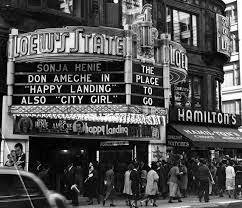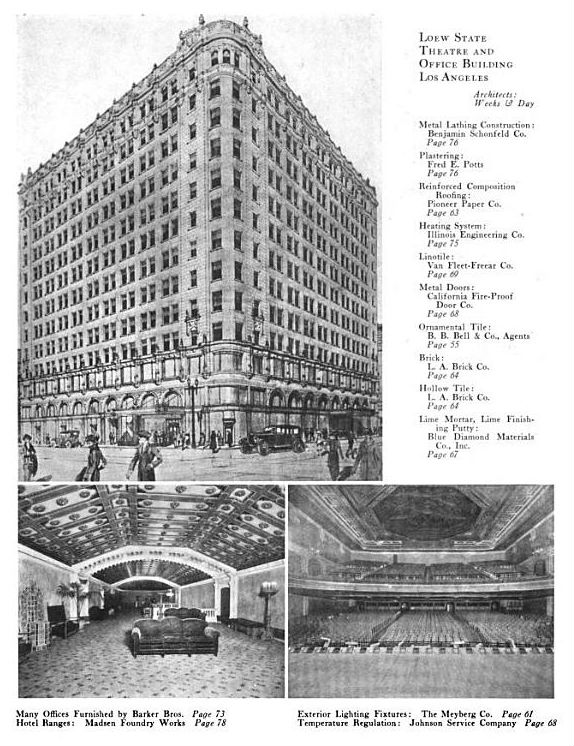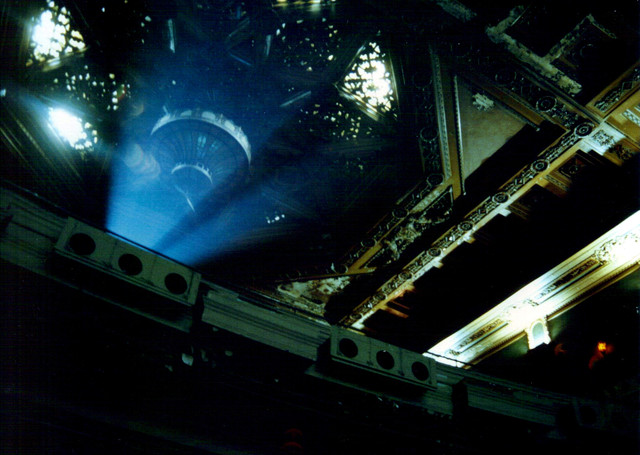Loews State Theatre
703 S. Broadway / Los Angeles


The theatre was christened by Viola Dana with a bottle of real champagne broken over the facade of the building on the the opening night.
Of the 2,800 seats, one thousand were sold to the public at a box office sale which started Thursday, Nov. 10, at 10 o’clock and closed at noon the same day.
The opening attraction was MGM's "Liliom." Marcus Loew was in attendance with a bevy of stars. Wonderfully successful as a vaudeville/movie house,
it featured elaborate stage shows by Fanchon and Marco with leading performers. Judy Garland sang here when she was still one of the Gumm Sisters.



Architectural Digest / 1922
“The new theatre is of Spanish renaissance architecture, in keeping with a California style. It is combined with a Moorish effect, which gives a gorgeous interior decoration.
Every seat in the house gives a broadside view of the stage. The ventilating system provides a mushroom distributor under each seat.
A vacant seat call designed by Manager Holt and W. F. Scott, the house stage director, and which is known as the Holtscott system, has been installed.
The stage curtain weights 1100 lb., and is made of velour. Special scene shifting apparatus makes it possible by means of pulleys to whisk the medallions from the stage floor in a few seconds.
The stage can be changed from three to fifty feet in size instantly. A six-manual Moller organ, costing $50,000, and an orchestra leader with twenty-five pieces furnishes the music.




- (L) Projection booth in 1920s, and... (R) looking up at the projection booth during movie -
Stars who participated were Buster Keaton, Ora Carew, T. Roy Barnes, Wanda Hawley, George Beban, Herbert Rawlinson, Bebe Daniels and Wallie Reid.
Fred Niblo was master of ceremonies and Bert Lytell introduced Mr. Loew.
The theatre was a blaze of lights both inside and out. It is the 200th theatre built by Marcus Loew and is the most completely equipped on the coast.
It is housed in a twelve-story building costing $2,500,000. The theatre proper cost $1,500,000. It was built by Woods Brothers, Weeks and Day, and is under
the direction of Ackerman and Harris, Western managers for Loew in San Francisco. Manager Nat Holt was formerly in charge of the Hippodrome.
(It) has a screen 24 by 44 1/2 feet... twice the size of any other screen in use in that city and pictures are furnished for it by what is said to be the
largest projection booth in the world. Marcus Loew sure did spread himself on the projection room.... (he) states that this theatre has the largest screen in the world.
He should also have stated that it had one of the best projection rooms, from a standpoint of equipment and the general layout, which is splendid.
"Three latest model Powers 6-B Cameragraphs, equipped with Type E lamps, constitute the projection machinery. Each machine is equipped with a speed control that is
operated from a remote control panel board, by which speed the projectors can be regulated from seven different points in the projection room. This is a very unusual
feature. There is also in the projection room two spot lights, a flood and a double stereoptican, for use in lighting effects in vaudeville acts.
Between each projector is telephone that is a talking and ringing station, by which you can talk to any one of the twenty telephone stations scattered through the theatre.
A special feature to this telephone station, which makes it very complete, is that any one of the telephone stations in the projection booth can be connected to the Bell
telephone on the house exchange, thereby enabling outside calls to be received or sent direct from the projection room. In case of an emergency this would be a tremendous
advantage as it would eliminate the necessity of having to go wherever a Bell telephone was in the house, which is generally quite a distance from the projection room.
The fire shutters are all suspended by chains from a master cord running directly over the magazines of the machines. The chains are connected to the master cord by a fusible
link, and should one of these fusible links melt, it would release all the fire shutters, closing every opening in the machine room except the vent flues. These shutters are
absolutely noiseless in their operation, and should there be a fire in the projection room, the audience would never be aware of it, as they would not hear the shutters falling.
Fresh air is supplied to the projection room from the outside through a large flue and the foul air is removed through a vent flue, to which are connected the vent flues from
the lamp houses. Connecting the lamp house vent flues to the main vent flue creates a steady draft in the main flue, even when the fan is not running, which keeps the projection room
supplied with fresh air. There are two special features in this connection: first it keeps the lamp house cool, which tends to lower condensor breakage, and second, if the ventilating
fan would break down on a hot day, the draft in the flue goes a long way toward cooling the projection room.
All rewinding is done in a separate room with an enclosed cabinet rewind, which has ten compartments for putting films in. There is also an open rewind for inspecting and repairing
films that have been damaged. The work bench is heavy and strong enough to do any kind of repair work necessary. The projection room has one feature that no other projection room in
the world has--a shower bath, with hot and cold water, for the projectionist.
Summing it all up this projection room is undoubtedly one of the best designed and arranged in the country. The equipment is up to date in every respect, and what is more important, the comfort
and convenience of the projectionist has been kept in mind along with other things. W. A. Cook, who will have charge of it, is certainly to be congratulated on having such a splendid 'outfit' with which to work."
In 1924 Marcus Loew engineered the merger of Metro with the Goldwyn Co. (which Sam Goldwyn had departed from in a 1922 power struggle) and the Louis B. Mayer group -- resulting in Metro-Goldwyn Pictures.
By 1925, Mayer's name was also part of the company name, thus becoming MGM.
MGM's prestige product was well suited to the type of theatres operated by the Loew's Corporation. Although at its height in the late 1920's, the circuit totaled only about 160 theatres, they were
typically lavish first runs in major cities. In the 30s and 40s, the theatre was operated for Loew's by Fox West Coast Theatres, as was the Loew's Warfield in San Francisco, the only other Loew's Theatre
at the time on the west coast.
In 1950 Fox West Coast turned the operation of the State over to United Artists Theatre Circuit (along with their United Artists downtown) as part of the consent decree. These two were part of around a dozen
Los Angeles area houses they were forced to divest themselves of. The State was sometimes listed in UA ads as the United Artists State. See a 1953 United Artists ad from the Ken McIntyre collection.
A renovation proposed in 1955 for the United Building/State Theatre. Fortunately it didn't happen.
In 1963, the State Theatre was acquired by Sherill Corwin's Metropolitan Theatres and was used for action flicks as well as Spanish product in its final years.
It's now being used as a church and seats 2,404. The current lease evidently expires sometime around 2017. The building is owned the Delijani family. They also own the Los Angeles, Palace and Tower theatres.
There were plans to turn the office building into condos. In 2008 Eric Richardson wrote on blogdowntown: "The United Building, better known as the State Theatre Building, could soon become home to 155 live-work condo units."
As of 2012, the United Building was still rented as offices and light manufacturing. No sign of the condos.


http://commons.wikimedia.org/wiki/Category:Loew's_State_Theatre_(Los_Angeles)> Wikipedia




- (L) 1920s coat-check tag, and... (R) Program -


- (L) 1953 Poster and... (R) 1989 Marquee, -